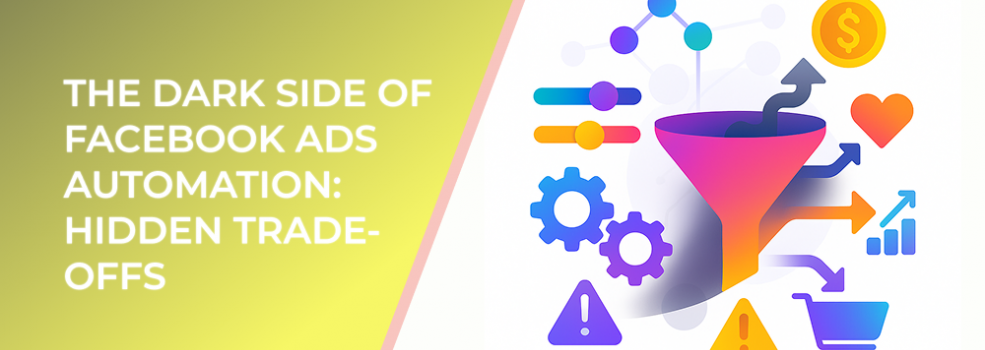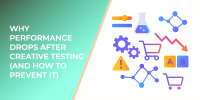Automation in Meta Ads (Advantage, Advantage+, ODAX objectives, dynamic formats, automated placements) has made media buying faster and more scalable. But speed can hide trade‑offs: loss of transparency, brittle performance, and blind spots that cost real money. This guide maps the dark corners so you can use automation on your terms.
Useful statistics at a glance
-
Learning fragility: A simple change (budget ±20–30%, new creative, or audience tweak) can reset or extend the learning phase, temporarily raising CPA/CPL by 10–40% until stability returns.
-
Spend concentration: In automated ad sets, 70–90% of spend often consolidates into the top 1–2 creatives, increasing the risk of creative fatigue if rotation isn’t managed.
-
Attribution whiplash: Switching between 7‑day click/1‑day view, 1‑day click, or modeled conversions can swing reported ROAS by 15–35% on the same spend window.
-
Audience overlap: Overlapping automated ad sets can push internal auctions to compete, raising CPMs by 5–20% at the account level.
-
Placement dependency: Automated placements can deliver 60–80% of impressions to the lowest‑cost inventory (e.g., Reels/Stories), which may depress downstream quality if your offer needs longer attention spans.
These ranges reflect common patterns we see across performance accounts and public Meta case studies; actual impact varies by vertical, AOV, creative, and sales cycle.
The hidden trade‑offs of automation
1) Opacity vs. Insight
Automation hides levers you used to read: per‑audience performance, creative‑by‑placement nuance, and bid dynamics. You see smoother averages but lose the “why.” That makes troubleshooting slower and hypothesis quality worse.
Mitigation: Preserve a small % of budget (10–20%) for structured tests outside the automated bundle to keep learning signals visible.
2) Learning Phase Fragility
Automated systems are sensitive to shocks. Large budget moves, multiple creative swaps at once, or significant audience changes reset the model, bloating CPMs/CPAs while it re‑learns.
Mitigation: Bundle changes; adjust budgets in ≤20% steps; schedule refreshes after midnight account time; stagger creative launches 24 hours apart.
3) Creative Winner‑Take‑All
The algorithm optimizes toward the quickest early‑signal winners. That’s efficient—but it often crowns a short‑term clickbait creative that underperforms on LTV.
Mitigation: Use guardrails (see below), enforce freshness SLAs (e.g., new concepts weekly), and evaluate winners on cost per qualified event (lead quality score, checkout start) not just CTR/CPC.
4) Attribution Drift
Small setting changes (window, modeled on/off) can make you think performance changed when only measurement changed.
Mitigation: Lock a default attribution window per funnel stage, annotate changes, and always monitor a business‑side source of truth (CRM, revenue) alongside Ads Manager.
5) Audience Canonicalization
Automation encourages broad, which is great for scale… until your niche ICP gets diluted, quality drops, or sales says, “Leads went cold.”
Mitigation: Feed the model high‑purity seed signals (value‑based conversions, qualified lead events), maintain exclusion lists, and keep at least one manual audience running as a benchmark.
6) Budget Pacing & Auction Harm
Multiple automated ad sets with overlapping objectives can compete in the same auctions and inflate costs.
Mitigation: Consolidate where intent overlaps, run overlap checks, and centralize budget in fewer, healthier ad sets.
7) Placement Mismatch
Auto placements tilt to cheap inventory. If your offer needs depth (e.g., B2B), fast‑scroll placements can inflate top‑funnel metrics while hurting conversion quality.
Mitigation: Use minimum placement guardrails (require Feed & IG Explore in tests), and run placement‑specific creatives when quality matters.
Guardrails to keep automation honest
1) Input discipline
-
Define and pass a qualified event (e.g.,
Lead_Qualified,AddToCart_50+,BookDemo) instead of generic leads. -
Sync offline conversions so the model sees pipeline value, not just form fills.
2) Change hygiene
-
Budget moves in ≤20% steps, every 24 hours.
-
Roll out creatives in batches of 2–3 with clear themes; avoid mass uploads that muddy learning.
3) Reporting sanity
-
Standardize an attribution window per stage.
-
Create a “Truth Dashboard” pairing Ads Manager with CRM/LTV.
4) Structure
-
Fewer, stronger ad sets. Over‑segmentation creates overlap tax and resets.
-
Use exclusions aggressively: existing customers, recent site visitors, unqualified geos.
5) Creative ops
-
Mandate a weekly concept and a bi‑weekly iteration cadence.
-
Pre‑tag concepts (Problem‑Solution, Testimonial, Demo, UGC) to analyze themes, not just ads.
Diagnostic checklist
Use this when performance dips under heavy automation.
-
Did anything change? (window, pixel event, budget, creative count)
-
Learning status? (Learning / Learning Limited / Active)
-
Spend concentration? (>70% on 1–2 ads)
-
Overlap risk? (audience intersections across ad sets)
-
Placement skew? (>60% in Reels/Stories for long‑form offers)
-
Quality proxy trending? (CPL good but MQL rate down)
-
Frequency & fatigue? (freq >3 in 7 days; falling CTR)
If you check 3+ boxes, pause new variables for 72 hours, then re‑introduce one lever at a time.
A pragmatic testing blueprint (4‑week cycle)
Week 1 – Baseline & Hygiene
-
Freeze attribution window; set budget change rules.
-
Launch 1 automated ad set (broad) + 1 manual benchmark (best audience) with identical creative themes.
Week 2 – Creative Concepts
-
Introduce 2–3 new concepts; cap total live ads at ≤6 per ad set.
-
Monitor qualified rate (MQL, checkout start) not just CPL/CPA.
Week 3 – Audience & Placements
-
Test one refined audience (LAL 2–5% or interest cluster) and one placement guardrail (Feeds‑required test).
Week 4 – Consolidate & Scale
-
Kill losers, consolidate budgets into 1–2 winners.
-
Scale in 15–20% steps; watch learning and overlap.
What to do when automation backfires
-
Stabilize signals: revert to last known good attribution window and event.
-
Reduce variables: freeze budget and creative count for 72 hours.
-
Rebuild seed quality: upload high‑value offline events and refresh exclusions.
-
Reset structure: merge duplicative ad sets; keep one clean broad + one benchmark.
-
Escalate creative: ship a new concept set; retire fatigued top spender.
Executive summary (for stakeholders)
-
Automation scales, but hides root causes and amplifies fragility.
-
Use it, but fence it: input quality, change hygiene, overlap control, creative cadence.
-
Judge success by pipeline outcomes, not only ad‑platform metrics.

